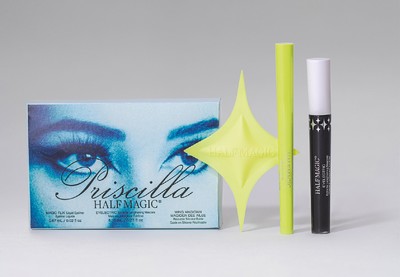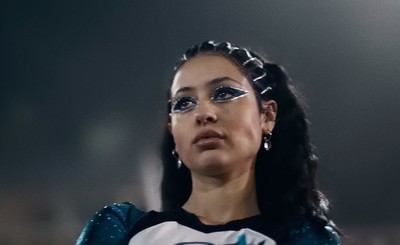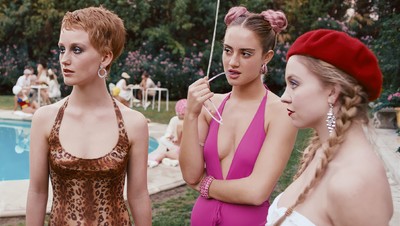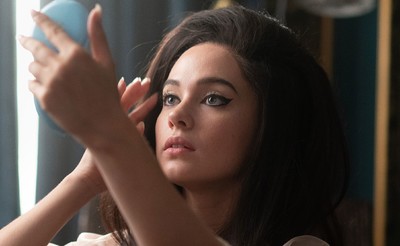By Sara McAlpine
Portrait by Max Farago
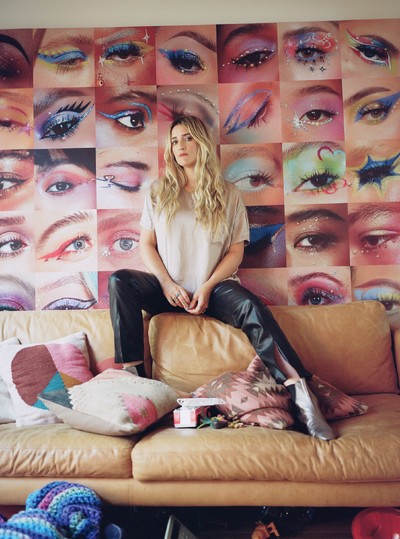
Make-up artist and co-founder, Half Magic
There are plenty of make-up brands launched off the back of make-up artists’ success in cinema, or offering specialist products for the screen; Max Factor, one of the world’s longest-running and most successful, among them. There are make-up brand collaborations with movie and TV franchises too: NYX and Barbie, Urban Decay and Game of Thrones. But a production company launching its own cosmetics brand, as A24 did in 2022, is atypical. When California-native Donni Davy was brought on as Head of Make-up for Euphoria, having worked on two quite different A24 films prior, no one could have predicted the impact of the high-colour, shimmering looks she created. Dramatic and expressive, intended to reflect the emotional intensity of teen life, #euphoriamakeup went viral, and characters’ graphic looks were the subject of myriad headlines and ‘how to’ tutorials across social media. Their impact reached far beyond the screen, inspiring Euphoria-style editorials in fashion magazines, and similar painterly, rhinestone styles on runways.
Davy, having won two Emmys for Outstanding Contemporary Make-up for the show, was as surprised as everyone else when, following its virality, A24 offered to co-found and back Half Magic, a standalone beauty brand – one that was available in Ulta and Beauty Bay, more than A24’s own e-store. Now, having established itself, it’s being tapped as a vehicle to promote the studio’s other productions, evolving beyond Euphoria, producing limited palettes intended to create altogether different looks by other make-up artists. For example, a sell-out winged-liner set for Sofia Coppola’s Priscilla, with other collections pegged to forthcoming projects.
Donni, how did your relationship with A24 begin?
My introduction to them was when I met [producer] Adele Romanski on the set of Moonlight, which was one of the first feature films I did, and when A24 was much smaller. I didn’t know much about film companies, but I knew they were doing cool stuff, and I thought, ‘I’m in if they ever want to hire me for another movie.’
What was the next project; were there more before Euphoria?
When Adele went on to produce another A24 film called Under the Silver Lake – starring Andrew Garfield – and the director David Robert Mitchell wanted really cool make-up. He was like, ‘I want colour. I want glitter. I want rhinestones. I want everything. I want make-up that goes off the clothes, and creates this very heightened sensory world around Andrew Garfield’s character.’ Until that point, my resume didn’t have any colour work on it, though. After Moonlight, I was actually getting more jobs wanting gritty make-up: lots of wounds and special effects; very realistic stuff. I really wanted to do more colour work. I landed Under the Silver Lake having put my own photoshoots together, showing I could do that. I worked out of grocery store parking lots with models and photographers that I found on Craigslist. It was deliberately more editorial-looking stuff. That movie put me much more on the radar of A24, especially because they were much bigger after Moonlight, meaning there were a lot more producers on set, so I feel like they were closer to my work. I guess it stuck with them, because a couple of years later, I was called to come in for the Euphoria pilot.
It’s interesting, because having a hair and make-up team that you know and frequently work with is common in fashion, but you wouldn’t expect that of a film and TV production company, where there are different directors and teams involved.
Often with hair and make-up it’s just like, ‘Okay, let’s just get who’s available.’ We’re brought on at the very last minute, usually the last department to come on and start prep, because there’s still this pretty old-school thinking about hair and make-up, that it’s just powder and hairspray. Nowadays, the whole relationship between talent and hair and make-up is extremely important. A lot of the editorial and red carpet make-up is so beautiful and so high-end, and then the actors start to get used to it, and they want that. I’ve never been interested in doing red carpet make-up, but I’ve always really wanted to bridge that gap between what you might call a traditional film and TV approach and the modern, endless possibilities of what make-up could be on the red carpet, in magazines, et cetera. With A24, they hyper-believe in creatives. That’s what they do with their directors; trusting their directors to create these wild, sometimes absurd, unusual films. And they’re really great risk takers, so I think when they sign up creatives, they’re just like ‘Well, we like this person, so we’re all in.’ It’s a really cool process to have the trust to bring more creativity to what you do.
In terms of the process, how do you approach each project?
It all depends on the director. [Euphoria creator] Sam Levinson, for example, had a pretty impressive, extensive make-up vocabulary to communicate what he wanted: colour make-up that’s gonna make people pause the screen to look again. I came in with a moodboard, he was like, ‘Yes, but more.’ He explained he really wanted me to use the show as a means to showcase make-up as self expression on these six characters.
What types of images were on the moodboard? Did fashion imagery play any role in creating these more ‘editorial’ looks, as you describe them?
A lot of gritty stuff, like photographs by Nan Goldin, Larry Clark film stills; there was Christina Ricci in Buffalo ’66. There was some fashion stuff, and also my fashion stuff mixed with shots from runway shows. They couldn’t look like runway looks, though. They had to bridge the gap between fashion editorial and real life. I had screenshots of girls on Instagram with pink, blushing noses and winged liner, and that kind of aesthetic that we still see now from Gen Z on TikTok. But these were before that all became mainstream.
‘I landed Under the Silver Lake having put my own photoshoots together, working in parking lots with models and photographers I found on Craigslist.’
‘I want make-up that makes people pause the screen’ is quite a mandate from Sam Levinson. What are your thoughts on the power of make-up, creatively and commercially, to have that impact? How much was the commercial aspect baked into the creative, considering you launched a make-up brand with A24 off the back of Euphoria?
Zero, for me. I was hired to direct the make-up department and deliver this vision, not thinking, ‘This is my break to have a make-up line or get famous.’ I was thinking more about the storytelling, and Sam wanted the make-up to be really visible for that to land successfully. Crazily, that resulted in people identifying with their make-up so much that it became a commercial thing. I should add that Sam loves make-up. He’s obsessed. He watches YouTube videos, he knows the lingo, and the way people make themselves up on Instagram. He loves it as a means of self expression. It became commercial once the show aired, and people reacted.
Let’s talk about the decision to launch Half Magic. There are so many collaborations between fashion and beauty brands these days, but you and A24 decided to launch a standalone line, rather than collaborating with an existing one. Why and how did that happen?
Well, the Euphoria make-up blew-up. My platform just exploded on social media, and I had so many followers and beauty magazines reaching out. I was doing interviews constantly, in every moment of free time. I could barely keep up with it all. Then brands started coming to me and asking to do little collaborations, like choosing the colours for an eyeshadow palette, or whatever. Then two of A24’s creative producers – Sam Levinson’s righthand guys – called me asking, ‘Hey, how’s it going?’, and I was like, ‘Good… brands are reaching out, it’s kind of crazy.’ And they were like, ‘Well, do you want to have a brand?’ Just like that on the phone. I said, ‘Sure, of course.’
Did you ask why they’d want to? Because it feels so unexpected for a TV and film studio to launch a standalone beauty brand.
First of all, I thought, ‘This is so fun’, because I love A24. And if the make-up was going to become commercial, which clearly it was, I was getting nervous about other brands coming to me saying, ‘We want you to design this huge campaign for this huge new launch’. I felt like I’d be cheating on A24 and Sam, giving all that creative energy to some huge multi-billion dollar make-up brand. It’s also this cultural movement we had developed, and I didn’t just want to give it to another brand. Clearly, at that moment in time, [A24] understood that the make-up had become hugely commercial, or else they wouldn’t have funded and co-founded it with me. I’m not a beauty person. I’m a film and TV make-up artist. I don’t know anything about the beauty industry, and they still trusted me, and I was kind of shocked. We all knew it would be a long process, where we’d have to find the right team and all that. I wasn’t wary, but I did think: ‘How are we going to do this? How are we going to build it from scratch?’
‘My Euphoria moodboards had Nan Goldin photos, Larry Clark film stills, Christina Ricci in Buffalo ’66, and Instagrams of girls with winged liner.’
Who did you have to bring on board to bring it to life?
The first person we brought on was a product developer; she is a little younger than me, and came from a high-end brand. Then our general manager, who’s a mastermind with 22 years of experience in building beauty brands from the ground up; working with huge, mega brands in-house.
Other beauty brands have to produce their own campaign imagery to market their brands. Is Euphoria a route to marketing Half Magic, using visuals from the show to create content?
This was a very important topic, because we are not a Euphoria make-up brand. HBO is not involved. We can’t use any verbiage from the show. We cannot use anything. But what I see in other brands is that they’ll have an eyeshadow palette called ‘Eye-phoria’. So, it’s funny that everyone else can capitalize on it. We don’t have any IP licence from the show, and we don’t really talk about it. What we have though, is me. So, I do loads of video content on my channels, and I can share Euphoria tidbits and stuff, but I can’t show screenshots or have an image of an actor and say, ‘I used this.’ I talk about Half Magic making those types of looks possible, and we talk about my experience in the film and TV industry, and as a thought leader now in the beauty community. I like to position myself a lot like a teacher – like a make-up fairy godmother-type, who can show you how to do certain looks and which products to use. We consciously didn’t pay to licence or call it ‘Euphoria make-up’. We wanted it to be different. We wanted it to stand on its own and be able to grow into whatever it would grow into; whatever’s happening culturally, and whichever other projects I have. We didn’t want to pigeonhole it.
How is that going to evolve beyond Euphoria?
I love the Euphoria aesthetic, so I bring some of that to the brand. Now there’s this commercial aspect of our brand that, in order to survive and thrive, we obviously have to sell products. To do that, we have to sell products to mainstream Middle America. An interesting thing that is happening now is this delayed effect with mainstream make-up. I look around and see it has barely hit the real mainstream until now. I’m seeing so many rhinestones everywhere – Beyoncé concerts, Taylor Swift concerts. It’s blowing up in the real mainstream, not just New York City and L.A., who have been on Euphoria make-up for a while. Our next mission is to show how we do everyday make-up. Another thing that is part of the Euphoria aesthetic is very lived-in skin, when your real skin shows through. So, we’re going to lean into that with the complexion. We plan to branch out into all categories, thinking beyond Euphoria terms all the time; bridging the gap between fantasy make-up, fashion and editorial make-up, and everyday life.
Traditionally, the runway dictated trends – even with make-up – and the role of cosmetics was for a luxury brand to have an accessible route to consumers. You’ve talked about the role of social media in both inspiring the Euphoria make-up, and being a way for you to engage and share with audiences
online. Are you more influenced by that than fashion and beauty imagery created by brands?
I’m super involved on TikTok, engaging with people there. The engagement and seeing how people are wearing Half Magic, and what they’re asking for really excites me, because people don’t hold back. It’s not just an aesthetic thing; it’s a category thing. ‘We need this’; ‘Give us a mascara’; ‘Give us a skin tint.’ And I’m like, ‘I’m working on it!’ I find that so interesting in terms of what I can build around this world of Half Magic. It’s almost like a meta narrative.
Are A24’s other films and shows also an outlet for them to promote Half Magic? Is that a conversation you’ve had?
Yes. It was kind of a mad dash to get everything set up and running, but now we’re working on collaborations with other projects. For example, we did a Priscilla box for the Sofia Coppola movie. But this is how a collaboration works on A24’s side: A24 has a very specific aesthetic. Half Magic is not sold on the A24 merch site, because we are a different company. We are a baby of A24, but we exist in our own hemisphere. We are moonlighting this concept of working collaboratively with A24 for movies they have coming out, having a little marketing moment. For Priscilla, it’s very much a ‘get the look’ type thing and will be sold on A24’s merch site and in Ulta. So, we’re doing the dream of what I thought in the beginning: how we’re going to utilize Half Magic in terms of A24 launches, and how we’re going to partner with them. They’re not just like, ‘We’re going to put our stamp on all the stuff’, because they’re very thoughtful. It doesn’t work like that. We don’t make a collection and put an A24 logo on it. That’s not the vibe or the A24 way.
